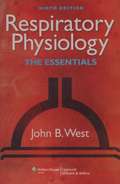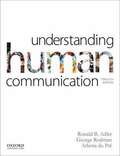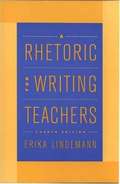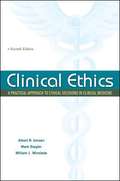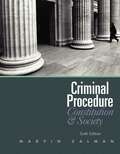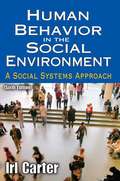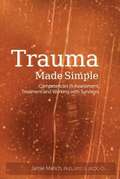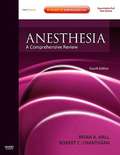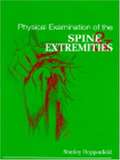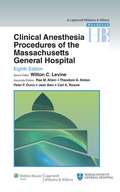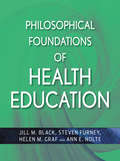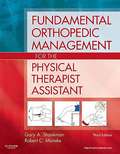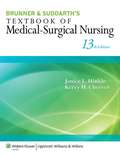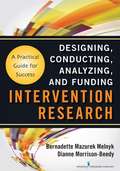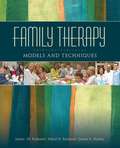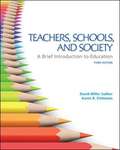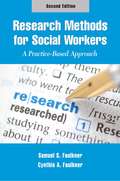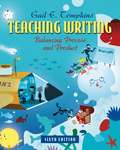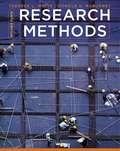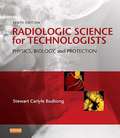- Table View
- List View
Respiratory Physiology: The Essentials 9th Edition
by John B. WestWidely considered the gold standard for the teaching and learning of respiratory physiology, this fully updated Ninth Edition includes key points for each chapter and multiple-choice review questions and answers with full explanations.
Understanding Human Communication Twelfth Edition
by Ronald B. Adler George Rodman Athena Du PreFor over three decades, this has been the bestselling text for the Human Communication course. Understanding Human Communication is written with one goal in mind: to provide students with the insights and skills to succeed in our changing world. Fully updated and expanded to include more information on culture and communication, gender and communication, and the effects of technology and social media on communication, this twelfth edition also features two new types of boxes, "Understanding Diversity" and "@Work," as well as new annotated sample speeches.
Abnormal Psychology: Clinical and Scientific Perspectives 5th Edition
by Charles A. Lyons Barclay MartinThis book intends to be a useful, reference resource that could serve as a primary text for students in undergraduate abnormal psychology courses and helps readers to understand the DSM-5 and to recognize the variety of treatments available.
Family Life Education: Integrating Theory and Practice
by Michael J. Walcheski David J. BredehoftThe twofold object of the book "Family Life Education: Integrating Theory and Practice 2nd edition" is to provide a text for the preparation of family life educators and a resource for the practice of family life education. It addresses many of the issues involved in the training of family life educators and the needs of the practicing family life educator.
A Rhetoric For Writing Teachers 4th Edition
by Erika C. Lindemann Daniel AndersonFrom answering the question "Why teach writing?" to offering guidance in managing group work and responding to assignments, A Rhetoric for Writing Teachers provides a comprehensive introduction to the teaching of writing. Now in a fourth edition, this remarkably successful book features a new chapter by Daniel Anderson on teaching with computers and adds updated material on invention, intellectual development, and responding to students' writing. Describing in straightforward terms the cross-disciplinary scholarship that underlies composition teaching, it opens with chapters on prewriting techniques, organizing material, paragraphing, sentence structure, words, and revising that show teachers how to lead students through composing. Sections on writing workshops, collaborative learning, and instructional technology reflect current views of writing as a social interaction. Chapters on rhetoric, cognition, and linguistics explain theoretical principles that support classroom practices and make teachers' performances more effective. Treating both the theory and practice of writing, this classic book encourages teachers to adopt the methods that best meet their students' needs and to develop a style of teaching based on informed decisions. It provides an extensive updated bibliography--including useful Web sites as well as important books and articles--and an updated table of important dates in the history of composition. A Rhetoric for Writing Teachers, 4/e, offers both prospective and seasoned writing teachers convenient access to influential scholarship in the field and inspires them to examine what it means to teach well.
Clinical Ethics: A Practical Approach to Ethical Decisions in Clinical Medicine (Seventh Edition)
by Albert R. Jonsen Mark Siegler William J. WinsladeThis book is about the ethical issues that clinicians encounter in caring for patients such as informed consent, truth telling, confidentiality, privacy, the distinction between research and clinical care, and end-of-life care.
Psychosocial Aspects of Disability (Fourth Edition)
by George Henderson Willie V. BryanThis new edition of Psychosocial Aspects of Disability strikes a balance of past, present, and future views of individual, family, societal, and governmental interaction and reaction to persons with disabilities. The past is presented in Part 1, Psychosocial Aspects of Disabilities, in which a view of the evolution of societal reactions to disabilities and persons with disability is presented. This perspective is important because it explains how some of the beliefs and attitudes toward disabilities and those who have a disability have developed. Additionally, Part 1 makes us aware from a historical perspective why persons with disabilities have been subject to certain types of treatment from family, friends, and society. Parts 2 and 3 provide discussion of present situations for persons with disabilities as they move toward better inclusion in society. Chapter 5 discusses the need for empowerment of persons with disabilities and how they can empower themselves. Chapter 6 discusses the need for better employment opportunities for persons with disabilities because this is a significant way of empowering persons with disabilities. Chapter 7 discusses federal legislation that has been developed to facilitate the empowerment of persons with disabilities. Part 4, Psychosocial Issues, to a large extent, represents the future for persons with disabilities. The chapters in this section discuss some disability issues that some persons with disabilities will encounter and/or by which they will be affected during the twenty-first century. Additionally, there is discussion of the need for persons with disabilities to attain the full human rights to which they are entitled.
Criminal Procedure (Sixth Edition)
by Marvin ZalmanUsing a blend of text and edited cases, CRIMINAL PROCEDURE, 6/e provides up-to-date coverage of constitutional criminal procedure. Important cases are highlighted using a case and comment approach-complete with analysis, justice quotes, and dissenting opinions. This edition includes 25 important new Supreme Court cases and 70 new citations to Supreme Court decisions. Each chapter is updated to reflect the most recent criminal procedure and new legal puzzles appear in every chapter. With an emphasis on law and society, it provides essential information about the law of constitutional criminal procedure, its social, political, and historical contexts, and the most meaningful Supreme Court cases.
Teaching, Bearing The Torch: Introduction to Education Foundations (Third Edition)
by Pamela J. Farris Patricia L. RiemanTeachers are torchbearers—leaders who impart knowledge, truth, or inspiration to others. Pamela Farris, joined by Patricia Rieman in the latest edition of this exceptional foundations text, clearly demonstrates how teachers bear the torch. The authors' well-researched approach provides both positive and negative aspects of education trends. Their generous use of examples shows how teaching and schooling fit into the broader context of U.S. society and how they match up with other societies throughout the world. Farris and Rieman's lively writing style instills teacher education candidates with a lucid understanding of such topics as philosophy and history of education, national trends, requirements of becoming a teacher, teachers' salaries, how schools are governed and funded, demographic changes and expectations for the future, differences in rural and urban schools, and use of technology. Detailed lists of a variety of websites provide additional resources. Anecdotes of professionals in the field—authentic-voice narratives with frank insights into real-world teaching experiences—punctuate the text. Boxed scenarios concentrate on important issues and educators, energize readers' interest, and stimulate proactive thinking. Other outstanding features are the book's affordability and versatility. Instructors can easily assign all or a portion of the chapters to fit course needs.
Human Behavior in the Social Environment: A Social Systems Approach (Sixth Edition)
by Irl CarterSince the publication of the first edition of Human Behavior in the Social Environment, several generations of students have successfully used this classic text, which takes a social systems approach to human behavior. This systems approach is still widely accepted in the human services disciplines, including social work, education, nursing, psychology, and in human services programs themselves. Its ideas have become the organizing framework for curriculum, as well as fruitful sources for new applications of theory and practice. Among the advantages of the social systems approach is that it permits students and practitioners to see connections between fields of practice, between methods, and across professional disciplines and bodies of theory. The book serves as a template of the concentric circles of human behavior, with chapters on fields of behavior, beginning with the person and ranging outward to culture and society. Abundant examples from practice and from behavioral patterns are drawn from the social sciences, topical events, literature, and the authors’ personal and professional experiences. This volume responds to the needs of students and instructors as these have developed since the publication of the previous edition.
Trauma Made Simple: Competencies in Assessment, Treatment and Working with Survivors
by Jamie MarichIn Trauma Made Simple, trauma expert Dr. Jamie Marich brings her practical style of training to print, using clinical common sense to wade through theory, research, and hype surrounding trauma. Learn about trauma in a way that is relevant to clinical work, including extensive coverage on PTSD and other diagnoses through a bio-psycho-social-spiritual lens. Make clinically informed decisions based on setting, client preparedness, and other contextual variables. Develop strategies for treatment planning based on the best possible treatments in the field today. Trauma Made Simple addresses a variety of issues that are imperative to trauma competency in clinical work, including how to handle grief and mourning, assessing for and addressing addiction (even if you are not an addiction counselor) and how to manage professional development issues, including self-care.
Anesthesia: A Comprehensive Review (Fourth Edition)
by Brian A. Hall Robert C. ChantigianAnesthesia: A Comprehensive Review is an invaluable study tool for certification and recertification as well as a superb way to ensure mastery of all the key knowledge in anesthesiology. Brian A. Hall and Robert C. Chantigian present nearly 1000 completely updated review questions-vetted by Mayo residents-that cover the latest discoveries and techniques in physics, biochemistry, and anesthesia equipment; the newest drugs and drug categories; and the most recent information on all anesthesia subspecialties. They cover everything from the basic sciences to general anesthesia and subspecialty considerations, with an emphasis on the most important and clinically relevant principles. Access discussions of each question as well as page references to major anesthesia texts. With online access to the text at expertconsult. com, you'll have the ultimate review guide for the ABA written exam. Tests your knowledge of anesthesia through the most comprehensive coverage of basic science and clinical practice for an effective review. Features questions vetted by Mayo residents to ensure a consistent level of difficulty from trustworthy sources. Features the full text online at expertconsult. com for convenient reference. Presents 997 thoroughly revised questions for the most current and comprehensive review of board material, covering the latest discoveries and techniques in physics, biochemistry, and anesthesia equipment; the newest drugs and drug categories; and the most recent information on all anesthesia subspecialties. Complies with the new ABA format so you have an accurate representation of the new question style and can prepare effectively. Includes discussions after each question, along with references to major anesthesia texts so it's easy to find more information on any subject.
Essentials of Surgical Pediatric Pathology
by Marta C. Cohen Irene ScheimbergEssentials of Surgical Pediatric Pathology is a clear and practical yet comprehensive guide for trainee pediatric pathologists and non-pediatric pathologists.
Physical Examination of the Spine and Extremities
by Stanley HoppenfeldUseful to students and clinicians, this text covers the process of physical examination of the spine and extremities.
Clinical Anesthesia Procedures of the Massachusetts General Hospital (8th Edition)
by Wilton C. LevineThis manual continues to emphasize the clinical fundamentals involved in the safe administration of anesthesia, perioperative care, critical care, and pain management.
Philosophical Foundations of Education (9th Edition)
by Howard A. OzmanNow in its ninth edition, Philosophical Foundations of Education provides readers with comprehensive knowledge about the various schools of thought that have comprised the philosophy of education throughout history. Highly readable, this chronological text gives insight into the individuals who helped develop various philosophies of education and provides historical information about how they lived and how they learned. In addition, each chapter covers each philosophy’s aims, methods, curriculums, teaching roles, advantages, and disadvantages. Covering not only how each philosophy evolved over time but also how these philosophies influenced subsequent educational practice, this popular textbook also challenges readers to apply what they have learned in their own profession and develop their own philosophies about education, instruction, and schooling.
Fundamental Orthopedic Management for the Physical Therapist Assistant (Third Edition)
by Gary A. Shankman Robert C. ManskeDesigned to meet the unique needs of physical therapist assistants, Fundamental Orthopedic Management for the Physical Therapist Assistant, 3rd Edition focuses on critical thinking and helps you apply fundamental orthopedic principles in physical therapy interventions. Clear explanations cover basic concepts such as the PTA's role in physical assessment of flexibility, strength, endurance, and balance, along with the specifics of tissue healing; medications; gait and joint mobilization; and an introduction to biomechanics. It also describes the application of therapeutic interventions for many orthopedic conditions by region and affliction. Edited by two experienced clinicians, Gary A. Shankman and Robert C. Manske, and written by contributors who are experts in their respective fields, this is your one-stop source for PTA practice in orthopedics. Clear explanations of difficult concepts are provided by experienced, practicing clinicians who address the specific needs of the PTA. Comprehensive coverage provides a "one-stop" source for all things orthopedic, from core concepts related to orthopedics to information about the PTA's role in physical assessment and interventions, in-depth reviews of types of tissue healing, biomechanics, and pharmacology. A focus on critical thinking and application helps to prepare you for the treatment room and for the clinical practicum portions of the curriculum. Key terms and learning objectives begin each chapter, useful as "checkpoints" to which you can refer to ensure content comprehension and study effectively for examinations. Over 500 illustrations reinforce concepts and procedures, supplemented by summary tables and boxes. End-of-chapter review questions prepare you for the types of critical thinking you will be required to do in practice. Unique! End-of-chapter glossaries define key terms. Appendices provide a quick reference for information such as laboratory values, common medications, and associated movements. A six-part structure organizes the book's material: Part I: Basic Concepts of Orthopedic Management begins with the essential concepts of teamwork and shared responsibility within the physical therapy team and then covers the basic areas of flexibility, strength, endurance, balance, and coordination. Part II: Review of Tissue Healing introduces the types of tissue, then discusses ligament, bone, cartilage, muscle and tendon healing before looking briefly at neurovascular healing and thromboembolic disease. Part III: Common Medications in Orthopedics focuses on common medications used in orthopedics, their actions, side effects, and possible impact on treatment. Part IV: Mobilization and Biomechanics deals with the basics of human movement including a chapter on gait, and provides information on joint mobilization. Part V: Management of Orthopedic Conditions by Region covers the body from the ankle, foot, and toes up to the shoulder, the elbow, and the wrist and hand, including a chapter on the spine. NEW! Part VI: Management of Orthopedic Conditions by Affliction includes chapters on hot topics such as rheumatic disease; pain and pain-related syndromes; and bracing, orthotics, and prosthetics.
Textbook of Medical-Surgical Nursing (Thirteenth Edition)
by Janice L. Hinkle Kerry H. CheeverPrepare for medical-surgical nursing practice and success on the NCLEX with Brunner & Suddarth's Textbook of Medical-Surgical Nursing, 13th Edition. A favorite resource for students and practicing nurses for almost a half-century, this book provides comprehensive yet accessible coverage of a broad range of medical conditions while focusing on the nursing process and the nurse's role in caring for and educating patients and families within today's complex health care delivery system. Up-to-date coverage of the health care needs of people with disabilities, nursing research findings, ethical considerations, and evidence-based practice gives you opportunities to refine your clinical decision-making skills. Fully updated and enhanced, this new edition provides a fully integrated solution that promotes clinical judgment, performance, and success on the NCLEX examination and in nursing practice. Key Features in the 13th Edition: NEW! Concept Mastery Alerts clarify difficult concepts, informed by data from Misconception Alert questions in PrepU for Brunner & Suddarth's Textbook of Medical-Surgical Nursing, 12e. NEW! Quality and Safety Nursing Alerts build upon previous edition's Nursing Alerts to highlight issues related to quality and safety nursing care. NEW! The updated unit openers include new Case Studies with QSEN Competency Focus to highlight a competency and related knowledge, skills, and attitudes. Additional information for these case studies related to NANDA-I, NIC, NOC and the nursing process is available online. NEW! Prioritization Questions have been added to the Critical Thinking Exercises. UPDATED! Genetics Charts and Ethical Dilemma Charts have been revised to reflect the latest advances in the field. UPDATED! Critical care information has been updated to further the authors' goal to have the most up-to-date and clinically relevant content on critical care throughout the book. EXPANDED! Expanded coverage of obesity, highlighted with a new icon, focuses on this epidemic health problem in our society. STEAMLINED! The Table of Contents has been reorganized for a more logical sequence and flow. REVISED! The accompanying Study Guide now features reorganized content and revised questions. Nursing Process sections, Plans of Nursing Care, and Critical Care sections More than 2,900 NCLEX-style review questions Assessment Charts, Risk Factor Charts, Guidelines Charts, Genetics in Nursing Practice Charts, Patient Education Charts, Health Promotion Charts, Ethics and Related Issues Charts, and Pharmacology Charts and tables. Gerontologic Considerations sections, Physiology/Pathophysiology figures, and Home Care Checklists Nursing Research Profiles and EBP questions help students learn the importance of evidence-based practice. Concepts in Action Animations bring anatomy, physiology and pathophysiology concepts to life.
Intervention Research: Designing, Conducting, Analyzing, and Funding
by Bernadette Mazurek Melnyk Dianne Morrison-BeedyThis book is a practical, user-friendly guide for health care researchers across multiple disciplines who are involved in intervention research. It provides all of the essential elements needed for understanding how to design, conduct, analyze, and fund intervention studies that are replicable and can withstand the scrutiny of the Institutional Review Board and peer review. Developed from an annual continuing education workshop on intervention studies conducted by Dr. Melnyk, this text is the most comprehensive body of information available on this topic. Contributors address the design of interventions that are ethically considerate and sensitive to culture, race/ethnicity, and gender, minimizing threats to external and internal validity, measurement, and budgeting. The guide explores such implementation issues as subject recruitment and retention, data management, and specialized settings, cost analysis, and explaining intervention effects. The text also guides readers in writing grant applications that fund, and addresses how to move intervention study findings into the real world. A unique addition to the book is the availability of digital examples of progress reports, final reports, and research grant applications that have received funding from the National Institutes of Health and other relevant organizations. This text is a valuable resource for all health care professionals conducting research and for doctoral students in health care studies. Key Features: Presents the essential tools for designing, conducting, analyzing, and funding intervention studies Designed for use by health care professionals conducting intervention research Provides comprehensive, accessible guidelines for doctoral students across all health care disciplines Instructs readers on writing grant applications that fund Includes digital examples of funded research grants, progress reports, and final reports.
Family Therapy: Models And Techniques
by Janice M. Rasheed James A. Marley Mikal N. RasheedThis text offers a straightforward, comprehensive overview of both traditional and evolving theoretical models of family therapy and intervention techniques as well as a discussion of clinical issues unique to family therapy practice. Aiming to prepare students to develop beginning proficiency in family therapy, the authors outline major family therapy models in detail, including a step by step description of concepts, theories, skills, and techniques as well as a history of each model and its conceptual and theoretical underpinnings. The text also provides extensive case illustrations of family interviews that identify the specific stages, clinical issues, concepts, theories and techniques associated with each model. This core text is designed for graduate level courses such as Family Therapy, Marriage and Family Therapy, Marriage and Family Counseling, Family Systems Theory, and Family Counseling in departments of social work, psychology, nursing, education, or human services.
Teachers, Schools, And Society: A Brief Introduction To Education
by David M. Sadker Karen ZittlemanDavid Sadker's and Karen Zittleman's lively writing style captures the joys and challenges of teaching. The text stresses the importance of fairness and justice in school and society, focuses on the most crucial topic areas, and integrates the most current issues in education. In addition, the wealth of activities included--from online video observations to portfolio-building exercises--offers a broad range of ways to introduce students to the teaching profession.
Research Methods for Social Workers: A Practice Based Approach (Second Edition)
by Samuel S. Faulkner Cynthia A. FaulknerSamuel and Cynthia Faulkner have developed the perfect research methods text tailored specifically for social work students that illustrates how understanding research is valuable for success in evidence-based agency practice. From the basics of research to practice evaluation, the authors carefully guide students through the complete process. They are able to connect abstract theory with practical applications, providing the skills necessary to become effective practitioners. The book introduces complex concepts such as qualitative, quantitative, and statistical methods; ethical issues in research; sampling; and measurement in a manner that students find readily accessible. What is most impressive about this new edition is that there is an additional 30% of new or updated material. Developed in part from suggestions made by students and faculty who have used the previous edition, these improvements include content and instructional features that will remind you why this is one of the best research methods books on the market! Features: NEW CSWE Core Competencies at the beginning of each chapter. NEW Practice exam at the end of each chapter. NEW! Case scenarios in each chapter demonstrating practical use of material along with associated critical thinking questions. NEW! Survey research chapter illustrating how to develop and conduct survey instruments. NEW! Example research proposal and example research report demonstrating how research is effectively gathered, processed, and presented. NEW! Examples throughout the text relating to social work practice.
Teaching Writing: Balancing Process and Product (Sixth Edition)
by Gail E. TompkinsThis best selling text by Gail Tompkins thoroughly examines genres and instructional procedures with a strong new focus on differentiating instruction to ensure success for all writing students. New chapters on the writer's craft and on writing across the curriculum offer detailed information on the six traits of good writing as well as writing in content areas, and new features provide insight into teaching English learners and using technology meaningfully in the writing classroom.
Research Methods (Ninth Edition)
by Donald H. Mcburney Theresa L. WhiteNow in its 9th Edition, RESEARCH METHODS provides psychology students with a scientific approach to understanding their field of study and the world in general. The text's logical, step-by-step coverage is the result of decades of author experience. It includes all of the stages of the research process, from selecting the project and searching for literature, to choosing a protocol and getting published. RESEARCH METHODS also presents students with problems from selected psychological literature to demonstrate some of the creative ways psychology professionals design and conduct effective research.
Radiologic Science for Technologists: Physics, Biology and Protection (10th Edition)
by Stewart Carlyle BushongThis textbook provides a solid presentation of radiologic science, including the fundamentals of radiologic physics, diagnostic imaging, radio biology, and radiation management.
